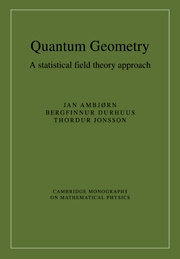Description
Quantum Geometry
A Statistical Field Theory Approach
Cambridge Monographs on Mathematical Physics Series
Authors: Ambjørn Jan, Durhuus Bergfinnur, Jonsson Thordur
Describes random geometry and applications to strings, quantum gravity, topological field theory and membrane physics.
Language: English
Subject for Quantum Geometry:
77.28 €
Subject to availability at the publisher.
Add to cart
Publication date: 12-2005
380 p. · 17x24.5 cm · Paperback
380 p. · 17x24.5 cm · Paperback
Description
/li>Contents
/li>Comment
/li>
This graduate/research level text describes in a unified fashion the statistical mechanics of random walks, random surfaces and random higher dimensional manifolds with an emphasis on the geometrical aspects of the theory and applications to the quantisation of strings, gravity and topological field theory. With chapters on random walks, random surfaces, two- and higher dimensional quantum gravity, topological quantum field theories and Monte Carlo simulations of random geometries, the text provides a self-contained account of quantum geometry from a statistical field theory point of view. The approach uses discrete approximations and develops analytical and numerical tools. Continuum physics is recovered through scaling limits at phase transition points and the relation to conformal quantum field theories coupled to quantum gravity is described. The most important numerical work is covered, but the main aim is to develop mathematically precise results that have wide applications. Many diagrams and references are included.
Preface; 1. Introduction; 2. Random walks; 3. Random surfaces; 4. Two-dimensional gravity; 5. Monte Carlo simulations; 6. Gravity in higher dimensions; 7. Topological quantum field theories; References; Index.
This book is about the influence of chance and fluctuating shape in quantum physics. It covers new research in some of the most exciting developments in modern physics, including string theory, gravity theory, and membrane physics. As a research text, the book is technical, but the authors have taken great care to focus on general methods with the widest possible applications. This volume will be of interest to graduate students and researchers in theoretical physics, particle physics, cosmology and mathematics.
© 2024 LAVOISIER S.A.S.
These books may interest you

Gravity and Strings 144.47 €



